Understanding Surfbreak: Wave Dynamics & Culture
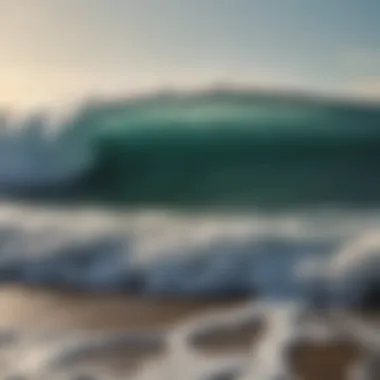
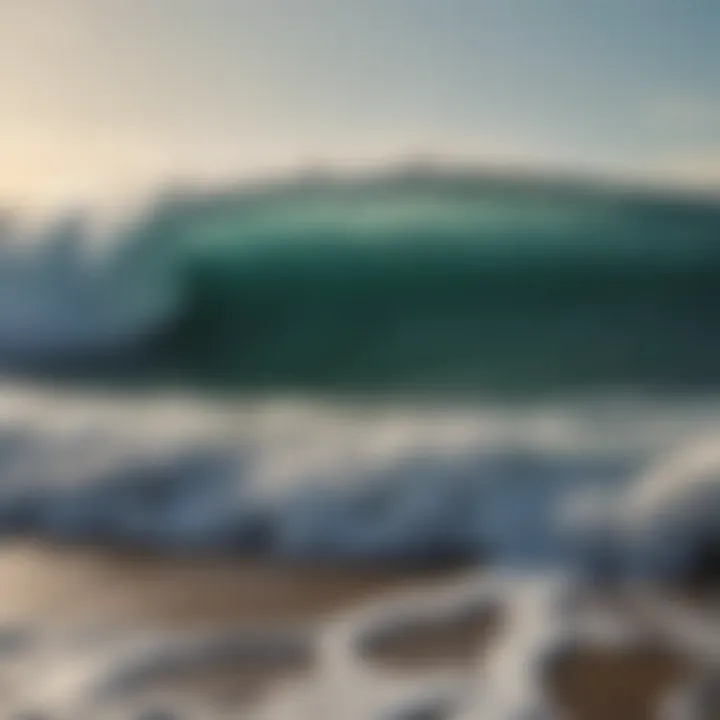
Intro
The concept of surfbreak is crucial for both surfers and environmentalists alike. This discourse explores wave formation dynamics and break patterns, emphasizing their significance beyond just recreation. Understanding surfbreak involves recognizing the interplay between natural forces and human activities. From surf culture to the health of coastal ecosystems, surfbreaks serve numerous purposes. Additionally, climate change's influence on these dynamics poses challenges that require attentive consideration.
Wave Dynamics
Formation of Waves
Waves form primarily due to wind energy transferring to the ocean surface. The strength of the wind, duration, and fetch—the distance over water that the wind blows—affect wave height and energy. Larger fetch and stronger winds generally produce more powerful waves. As waves travel across the ocean, they may lose energy due to friction with the seafloor.
Break Patterns
When waves approach the shore, their behavior changes. The slope of the ocean floor and water depth influences how and where a wave will break. The common break patterns include:
- Beach break: Waves break over a sandy bottom.
- Reef break: Waves break over coral or rocky reefs, often creating more powerful surf.
- Point break: Waves break along a point, wrapping around before crashing.
Understanding these patterns is crucial for surfers looking to choose optimal surfing conditions.
Surf Culture
Significance to Surfers
Surf culture extends beyond mere wave riding. It embodies a lifestyle intertwined with the ocean, fostering a community that values nature and adventure. Surfers often share a profound respect for the environment, advocating for sustainable practices to protect coastlines.
Global Influence
Surf culture varies across regions, taking on unique characteristics influenced by local traditions and environments. From the laid-back vibe of California to the dynamic scene in Australia, these cultures shape the surfing experience.
Environmental Factors
Impact of Climate Change
Climate change significantly alters surfbreak conditions. Rising sea levels, ocean warming, and increased storm activity can reshape coastlines, affecting surf quality. Many surfers notice a change in their local break patterns as a result of these shifts. Surf spots that were once reliable may become unpredictable or even disappear.
This underscores the necessity of environmental consciousness among surfers and the importance of research in this area.
Ecosystem Significance
Surfbreaks also play a vital role in coastal ecosystems. They help shelter marine life and contribute to beach erosion prevention. The balance between surfing activities and ecological integrity is a subject requiring ongoing attention.
Technology in Surfing
Advancements in technology are changing how surfers assess conditions. Applications provide real-time data on wave height, tides, and wind conditions. Drones and surf cameras capture footage, allowing surfers to scout break conditions without being physically present. This not only improves safety but enhances the overall experience of catching waves.
Prolusion to Surfbreak
The topic of surfbreak is essential when examining the world of surfing and water sports. Understanding the dynamics behind wave formation and break patterns offers insights not only for surfers but also for environmentalists and coastal planners. Knowledge of surfbreaks allows surfers to choose suitable spots for riding waves, while also highlighting the ecological significance of these areas. Surfbreaks contribute to marine biodiversity and coastal resilience, supporting both local economies and ecosystems.
Definition of Surfbreak
A surfbreak refers to the point where ocean waves break and can be ridden by surfers. This breaking occurs due to various factors including the shape of the ocean floor, wave height, and the direction of the swell. The interaction of waves with the seabed creates different types of breaks, which are critical to defining where and how a surfer catches a wave. By understanding these mechanics, surfers can improve their skills and experience.
Significance in Surf Culture
Surf culture is deeply intertwined with surfbreaks. For many surfers, the experience of waiting for the perfect wave is not merely a physical activity, but a spiritual one. Each surfbreak has its own character and community, drawing local surfers and tourists alike. The quality of a surfbreak can dictate the overall enjoyment and challenge a surfer experiences. Moreover, famous breaks like Pipeline in Hawaii or Teahupo'o in Tahiti are celebrated not just for their waves but for the unique lifestyle they represent.
"Surfing is much more than a sport; it is a way to connect with nature and oneself. The surfbreak is the stage upon which this connection unfolds."
The presence of a reliable surfbreak can elevate the status of a location, turning it into a hotspot for surf tourism. This tourism supports local businesses and promotes environmental awareness surrounding the preservation of coastal areas. Understanding surfbreaks helps surfers of all levels appreciate the ocean's power and beauty, emphasizing respect for thoughtful engagement with natural resources.
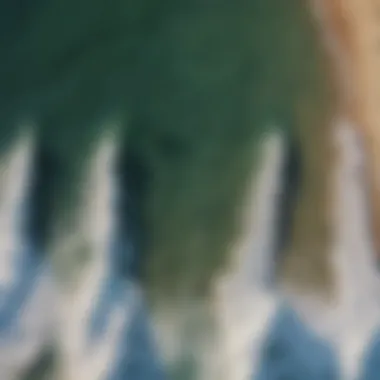
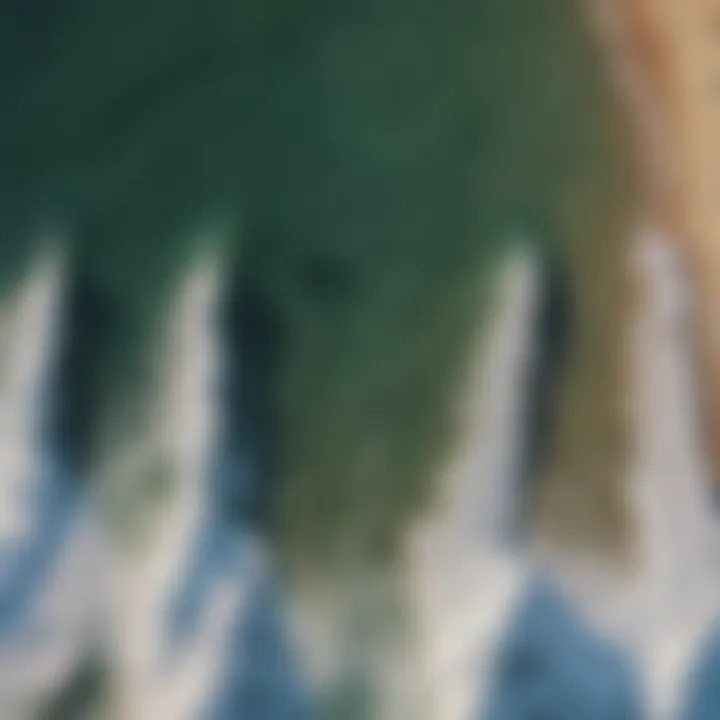
The Science of Waves
The study of waves is crucial to understanding surfbreak, as it focuses on the fundamental processes involved in wave formation and their behavior when they reach the shoreline. This section dives into the mechanics and classifications of waves, providing indispensable knowledge for both surfers and environmentalists. By understanding these dynamics, enthusiasts can better anticipate surf conditions, and protect coastal ecosystems. Also, awareness of wave types leads to improved strategies for wave riding and enhances overall safety.
Wave Formation Mechanics
Waves form primarily due to wind. As wind blows across the water, it transfers energy, creating ripples that grow into full-fledged waves. This energy transfer is influenced by wind speed, duration, and fetch—the distance over which the wind blows. Initially, small waves, called ripples, develop, gradually increasing in height and length.
Factors like ocean depth, seabed topography, and coastal structures further impact wave dynamics. When waves approach the shore, they begin to interact with the bottom contours of the ocean floor. This interaction causes waves to increase in height and decrease in speed. Eventually, when a wave becomes too steep, it breaks, leading to the characteristic surf we see at beaches.
Types of Waves
Constructive Waves
Constructive waves are typically low-energy, gentle waves. They have a long wavelength and low frequency, usually resulting in a slow approach to the shore. Key characteristics of constructive waves include minimal height and limited power. These waves provide stability to beaches, promoting the deposition of sand and fostering healthy coastal environments. A main advantage of constructive waves in this article is their role in forming and maintaining surfable breaks, especially in sandy regions.
Destructive Waves
Destructive waves, in contrast, possess high energy and shorter wavelengths. They are characterized by their steep and powerful breaking, causing significant erosion along coastal areas. Destructive waves remove material from the shoreline, making it a popular topic in coastal management discussions. Their unique feature is the capacity to reshape coastlines quickly, which can be both an advantage and a disadvantage. On one hand, they can create excellent surfing conditions; on the other hand, they pose a threat to coastal features.
Wind Waves
Wind waves arise mainly from local wind conditions. These waves vary widely in size and strength based on wind speed and duration. Key characteristic of wind waves is their quick formation and dispersal. In this article, wind waves are significant for surf forecasts, as they can create ideal conditions for surfing at specific times. While smaller wind waves are often easier to manage for beginners, larger wind waves can deliver thrilling experiences for seasoned surfers.
Tsunami Waves
Tsunami waves are among the most powerful ocean phenomena. Generated by seismic activity, they can travel vast distances across oceans at incredible speeds. The key characteristic of tsunami waves is their immense energy and long wavelength. While they are not typically surfable, understanding their impact on coastal areas is essential for safety and awareness. The unique feature of tsunami waves lies in their destructive capabilities. They can reshape coastlines and cause significant changes in surf patterns, making them an important topic for environmental studies.
Wave Energy and Dynamics
Wave energy refers to the movement of energy through the ocean via waves. This energy has various applications, from generating electricity to understanding climate patterns. The dynamics of wave energy capture involve complex interactions between waves, wind, and the ocean floor . Wave energy not only affects surf conditions but also plays a role in regulating coastal ecosystems. Surfers can use this understanding to identify optimal surf times, contributing to a safer and more enjoyable experience.
Understanding the dynamics of waves enhances both the surfing experience and coastal management strategies.
Types of Surfbreaks
In this section, we delve into the various types of surfbreaks. Understanding these different surfbreaks is crucial for both surfers and those studying coastal dynamics. Each type of surfbreak has unique characteristics influenced by environmental factors, wave dynamics, and geography. This knowledge not only helps surfers choose their spots according to skill level but also provides insight into the ecological balance of coastal areas. Different surfbreaks attract various types of wave riders, from beginners to experts, each with specific needs and preferences.
Beach Breaks
Beach breaks occur on sandy bottoms and are the most common type of surfbreak. Waves break over shifting sands, which can vary with tides and swell. The result can be a more unpredictable surf session due to the changing conditions. Several factors can make beach breaks ideal for different surfers.
- Varying Wave Strength: Beach breaks can produce waves of different sizes and shapes based on the swell direction and tide. This makes them suitable for various skill levels.
- Potential for Peak Variety: A beach break may have multiple peaks, which can help distribute people in the water. This contributes to maintaining a more enjoyable experience for all surfers.
- Access and Safety: Often located in more accessible areas, beach breaks allow for easier travel and surfing with limited hazards like rocky bottoms. However, surfers should remain cautious of rip currents, which can be hazardous.
Point Breaks
Point breaks are another significant type of surfbreak where waves form as they wrap around a point of land. These breaks are renowned for their elongated rides, making them highly sought after by experienced surfers.
- Predictable Waves: Point breaks typically offer more consistent waves than beach breaks since they are less influenced by changing conditions.
- Longer Rides: The nature of a point break often allows surfers to ride waves for extended distances, which is appealing to many. They are sometimes regarded as some of the best breaking waves globally.
- Skill & Competition: Due to their nature, point breaks are often best suited for intermediate to advanced surfers, as they require a certain level of proficiency. This can lead to more competitive environments.
Reef Breaks
Reef breaks occur when waves break over a coral or rocky reef. They provide some of the most powerful and thrilling waves but are not without risks.
- Quality of Waves: Reef breaks often produce high-quality waves that can be hollow and challenging. This makes them credible locations for advanced surfers seeking the ultimate ride.
- Environmental Concerns: Surfers at reef breaks must be aware of the fragility of coral ecosystems. Understanding and mitigating impacts on these locations is crucial for long-term conservation.
- Access Challenges: Getting to some reef breaks can be difficult. Sometimes they are far from shore or require a boat. Proper knowledge about the locality is essential to make the most of these surf conditions safely.
River Mouth Breaks
River mouth breaks occur at the point where a river meets the ocean. These locations can provide unique surfing experiences.
- Dynamic Landscapes: The interaction between freshwater and ocean currents can create varied wave patterns. This unpredictability appeals to adventurous surfers.
- Environmental Impact: Being aware of the changing sediment patterns caused by river flows is important for understanding how often and when these breaks will work well.
- Seasonal Variations: The quality of river mouth breaks can change seasonally, depending on rainfall and flow patterns, making them exciting to explore at different times of the year.
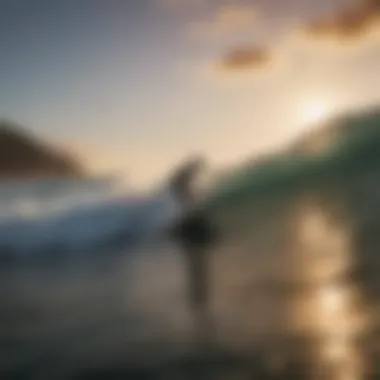
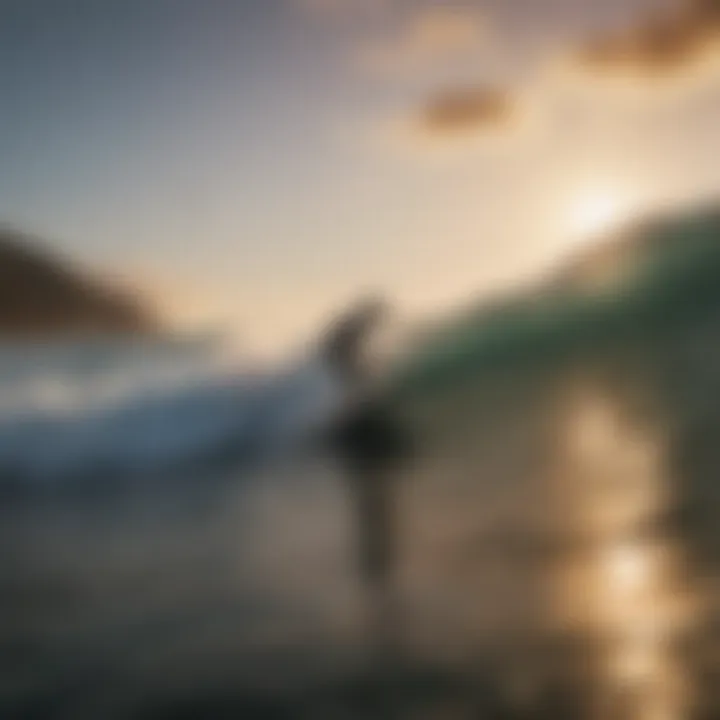
Understanding these different types of surfbreaks is vital not just for surfers but also for environmentalists and coastal planners. They each contribute uniquely to local ecosystems and cultural practices. The knowledge about these breaks enhances the overall surfing and environmental experience.
Environmental Influences on Surfbreak
Understanding the various environmental influences on surfbreak is crucial for both surfers and researchers. These influences range from the impact of wind patterns to geographical factors, tidal movements, and climate change. Each component plays a significant role in shaping how waves break along coastlines, ultimately affecting surf quality and safety. A nuanced grasp of these elements helps surfers anticipate conditions and adapt their techniques accordingly.
Impact of Wind Patterns
Wind patterns critically shape the character and quality of surf. They direct the formation and height of waves, influencing whether they will be clean and powerful or disorganized and choppy. For instance, offshore winds help to groom waves, allowing them to break more evenly, while onshore winds tend to create rough conditions.
Different areas have varying wind patterns throughout the year. Local knowledge about these patterns can enhance one's surfing experience. Factors such as the direction, speed, and consistency of winds intersect with seasonal changes, making them essential to consider for any surf-related planning. Weather systems, including storms, can dramatically alter expected conditions, leading to sudden swell increases.
Geographical Factors
The geographical features of a coastline significantly impact surfbreak dynamics. Coastal formations determine where and how waves will break. For example, point breaks, which result from land protruding into the ocean, create longer, more rideable waves, while beach breaks are often more unpredictable due to changing sand bars.
Additionally, underwater topography such as reefs and ledges also plays a crucial role. These formations can amplify wave energy, creating steeper and faster-breaking waves. Recognizing how these geographical features interact with incoming swells can provide surfers insights into the best surf spots in a region.
Tides and Their Effect
Tidal movements can have profound effects on surf conditions. The difference between high and low tide can introduce significant changes in wave height and quality. Often, certain surf breaks work best at specific tides due to the availability of sandbars and channels.
Surfers should be aware of tidal tables to optimize their surfing outings. For instance, a break that works well during a low tide may become too flat and weak at high tide, while others might offer better conditions during high tide. Monitoring tides helps in making informed decisions about when to hit the water.
Climate Change Impacts
Climate change poses increasing threats to surfbreaks around the world. Rising sea levels, changing weather patterns, and increasing storm frequency can all affect coastal dynamics. As ocean temperatures rise, the behavior of waves can alter dramatically, affecting not only surf quality but also the safety of surfing conditions.
Additionally, coastal erosion, exacerbated by climate change, threatens the stability of many famous surf spots. The long-term sustainability of these breaks is contingent upon understanding and addressing the broader impacts of climate change. Surfers and coastal communities must work together to advocate for policies that protect their local environments, ensuring future generations can enjoy surfing.
"Knowledge about environmental influences is essential for every surfer. Adaptation and awareness can lead to better performances and safer conditions."
Understanding these factors creates a comprehensive foundation for appreciating surfbreak dynamics. By integrating this information, surfers can enhance not only their skills but also their relationship with the ocean.
Surfbreak and Sustainability
Surfbreaks are not only vital for the surfing community but also play a significant role in the broader ecological context. Understanding the sustainability of surfbreaks involves examining how they are affected by various environmental factors and human activities. As climate change progresses, these dynamics shift, creating the need for proactive measures to protect surfbreak ecosystems and the communities dependent on them.
Erosion Issues
Erosion is a major challenge faced by many surfbreaks around the world. Waves crashing against coastlines can lead to the gradual wearing away of land, impacting the surfbreak itself. This process can be exacerbated by human activities like construction and beach nourishment practices. The loss of beach quality and shape can affect wave formation. If the sandbars shift or diminish, the once reliable surfbreak can become inconsistent or disappear entirely. Knowledge of coastal erosion is essential for surfers to understand their local breaks and advocate for better conservation practices.
Conservation Efforts
Efforts aimed at conserving surfbreaks are becoming increasingly important as surfers and environmentalists work together to address the threats posed by erosion, pollution, and climate change. Various organizations, such as the Surfrider Foundation, engage in initiatives designed to protect water quality, restore habitats, and promote sustainable coastal policies. These efforts often include:
- Clean-up initiatives: Regular beach clean-ups to reduce pollution and maintain the natural habitat's integrity.
- Advocacy campaigns: Promoting legislation that addresses coastal protection and the responsible use of shoreline resources.
- Educational programs: Offering resources for surfers to learn about local ecosystems, sustainability practices, and how they can contribute.
Involving the local surf community in conservation work enhances awareness and fosters a greater sense of responsibility toward the environment.
The Role of Surfers in Conservation
Surfers are uniquely positioned to influence the health of surfbreaks and advocate for sustainability. Their deep connection to the ocean often motivates them to take action. By participating in local conservation efforts, surfers can:
- Raise awareness: Surfers can inform others about the impacts of pollution and coastal development on surf conditions.
- Participate actively: Joining forces with local organizations can amplify conservation messages.
- Lead by example: Respecting the environment and practicing responsible surfing can inspire others to follow suit.
"Surfers wields a powerful voice in championing the health of surfbreaks, showcasing their commitment to safeguarding the waves they love."
Surfers embracing this role not only aids in protecting surfbreaks but also enhances the overall experience of surfing by ensuring waves remain consistent and enjoyable for future generations.
Technological Advances in Surf Forecasting
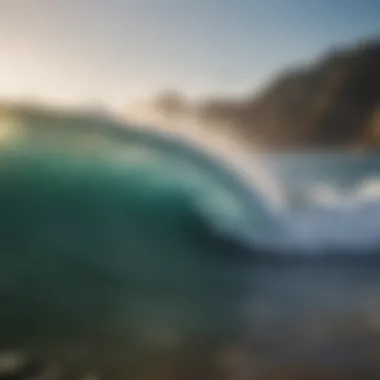

In recent years, the realm of surf forecasting has undergone significant transformation due to the rapid advancement of technology. This section examines those key technologies that have improved our ability to predict surf conditions, an essential aspect for both surfers and coastal management.
Wave Forecasting Models
Wave forecasting models are crucial for understanding surf conditions. They rely heavily on complex algorithms and data inputs that simulate the interactions of wind, ocean currents, and wave patterns. These models use various meteorological and oceanographic data to predict wave height, direction, and period. Implementing these models allows surfers to access reliable forecasts, enabling them to choose optimal times for hitting the water. The accuracy of such predictions depends on the integration of real-time data, historical records, and advanced mathematical techniques. Key models include the Global Forecast System (GFS) and the WAVEWATCH III. Both these models have revolutionized how enthusiasts approach their surfing sessions.
Use of Drones and Satellite Imagery
The utilization of drones and satellite imagery is an emerging trend in surf forecasting that offers unique advantages. Drones can capture high-resolution images of surf breaks, allowing for real-time assessment of wave conditions. They can provide insights that are not possible through traditional methods like buoy readings or visual inspection from the shore. Satellite imagery complements this by providing extensive coverage of entire coastlines and can track changes in surf conditions over time. This combination enables surfers and forecasters to monitor oceanic variables such as swell size and wind direction, making it a powerful tool for pre-surf planning.
Real-Time Data Collection
One of the most significant advances in surf forecasting is real-time data collection. Modern sensors can gather accurate information on wave heights, wind speed, and water temperature instantaneously. Surfers now have access to live data through various apps and websites that compile this information for specific locations. This capability allows surfers to adjust their plans on the fly, ensuring they are at the right break at the right time. Real-time data also aids in coastal management by providing crucial information that can address erosion concerns and habitat preservation strategies.
"Technology is reshaping the way we interact with waves. Accurate forecasts enable us to respect the ocean and adapt our practices accordingly."
Overall, the technological advances in surf forecasting are invaluable. These developments not only improve individual surfers' experiences but also contribute to broader environmental awareness and coastal conservation efforts.
Case Studies of Iconic Surfbreaks
Case studies of iconic surfbreaks provide a valuable framework for understanding the diversity and impact of surfing locations globally. Each surfbreak has unique characteristics shaped by environmental factors, which in turn influence surfing techniques, safety, and ecological significance. Analyzing these specific surfbreaks not only reveals the nature of each wave but also emphasizes the connection between local communities and their surfing heritage. Therefore, these case studies offer a glimpse into how surfers interact with their environment, the challenges they face, and the conservation efforts necessary to protect these treasured locales.
Pipeline, Hawaii
Pipeline, located on the North Shore of Oahu, is often regarded as one of the most famous surf breaks in the world. This wave is characterized by its powerful and hollow tubes, which form when swells from deep ocean depths collide with the reef. The break is known for its high skill requirement, attracting professional surfers and thrill-seekers alike.
The geography of Pipeline, with its unique underwater topography, supports the formation of its iconic waves. Consequently, conditions can be perilous. Many surfers come to test their abilities, but the risks are significant due to the shallow reef structure. This environment has sparked a culture of respect and responsibility among surfers. Efforts to preserve Pipeline involve both surfers' initiatives and community-driven conservation practices.
Teahupo'o, Tahiti
Teahupo'o is another incredible surfbreak located in Tahiti, recognized for its heavy and thick waves that break over a shallow reef. This break is infamous for its raucous power and challenging conditions, making it suitable only for highly skilled surfers. The wave's unique formation creates massive barrels, captivating both surfers and spectators.
The local community closely engages with this surfbreak, promoting it through contests like the World Surf League events. These competitions not only showcase talent but also spotlight local culture and environmental stewardship. Learning from Teahupo'o's mechanics offers insights into managing and protecting surf ecosystems globally.
Bondi Beach, Australia
Bondi Beach is an iconic surfing location known for its accessible waves and vibrant beach culture. Located in Sydney, Australia, Bondi draws surfers of all skill levels, making it a consistent site for both recreation and competition. The beach experiences a mix of beach breaks, allowing for various surfing experiences depending on the tide and swell states.
The social aspect of Bondi extends beyond surfing. It serves as a meeting ground for diverse individuals, fostering a sense of community among enthusiasts. Environmental challenges like erosion and pollution perpetually pose threats to Bondi, drawing attention to the immediate need for local conservation initiatives. These factors elevate the importance of understanding surf dynamics in urban settings.
Jeffreys Bay, South Africa
Jeffreys Bay, known for its long left-hand point break, stands as a pivotal surf destination in South Africa. The wave's length and consistency have made it famous among professional surfers. The nature of this break allows surfers to ride the wave for an extended period, making it a desirable location for both practice and competition.
The surf culture in Jeffreys Bay extends beyond sports. It embodies tourism and local economies, which hinge on the reputation of its waves. However, this popularity has led to ecological concerns. Efforts focusing on sustainable practices are essential to maintain the area’s health. Thus, Jeffreys Bay exemplifies the balance between surf culture and environmental preservation practices.
Understanding the dynamics at celebrated surfbreaks like Pipeline, Teahupo'o, Bondi Beach, and Jeffreys Bay illuminates the relationship between surfers and their environment. These case studies highlight not only the thrills of surfing but also the mutual respect required to protect these natural wonders.
By examining these locations, readers gain insights into how wave formation and break patterns influence surfing styles and environmental interactions, all while considering the necessity for community awareness and conservation efforts.
Ending and Future Perspectives
The discussion surrounding surfbreaks is not just academic; it holds significant relevance for the future of surf culture and coastal ecosystems. Surfbreaks are dynamic entities that evolve due to multiple factors: environmental changes, local community engagement, and advances in technology. Each of these elements plays a role in shaping the significance of surfbreaks, making it imperative that surfers, ecologists, and policy-makers understand these trends.
The Evolution of Surfbreaks
Surfbreaks are continuously influenced by natural processes. Historical shifts in coastlines, sediment transport, and human activities such as urban development and beach nourishment have altered many iconic surf locations. For instance, beaches that were once renowned for their consistent breaks may experience changes due to rising sea levels or alterations in wave dynamics.
Moreover, technology has revolutionized the way surfers interact with surfbreaks. The advent of real-time data collection tools, including buoy systems and mobile apps, has configured how surfers assess surf conditions. Going forward, we expect that machine learning models will be utilized to provide better predictive analyses of surf conditions. This could empower surfers to make informed choices about when and where to catch the best waves.
Emerging Trends in Surf Sports
The realm of surf sports is witnessing some important trends that impact surfbreaks. Topics like sustainability and environmental stewardship are becoming central to surfing culture. Surfers are more attuned to how climate change affects coastal conditions, and many are getting involved in local conservation efforts to protect surf environments. Initiatives like beach clean-ups and wave preservation advocacy are gaining traction.
Additionally, the increasing popularity of alternative surf crafts, such as foils and soft-top boards, shows a shift in how surfers engage with the waves. These new styles bring fresh challenges and changes to traditional surfbreak dynamics.
In summary, as we move forward, the evolution of surfbreaks and the trends in surf sports will continue to shape the future landscape of surfing. This evolving interaction between community, environment, and technology is crucial in advocating for sustainable practices that can preserve these dynamic surfing resources for generations to come.







